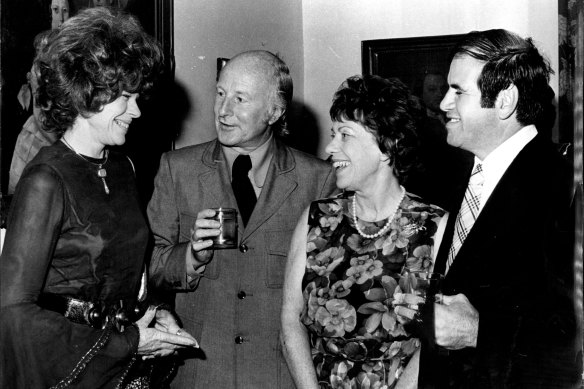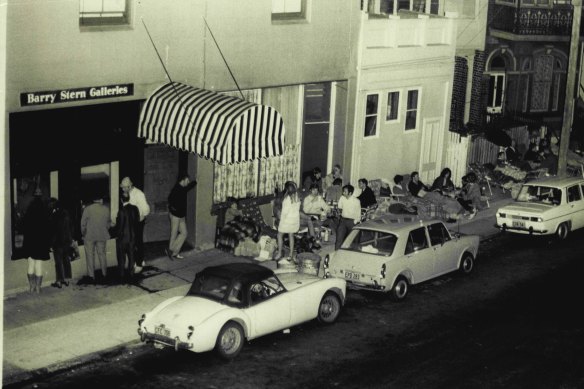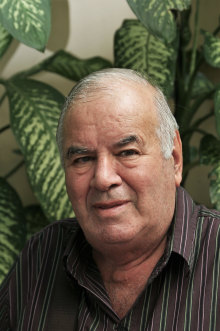Art dealer in right place as Paddington became a bohemian district
BARRY STERN: 1932 - 2024
Barry Stern moved to Paddington in inner Sydney when it was yet to see its glory days as a centre for the arts and where contemporary Australian art was not widely appreciated or recognised. In his career, he transformed it, promoting such art, encouraging and mentoring artists and promoting their work to such an extent that he had an international clientele. His death on July 1 brought an outpouring of grief and tributes from Sydney’s art community.
“Barry was a man of taste, energy, charm and boundless enthusiasm, just what Sydney needed in the early 1960s,” said art dealer Rex Irwin. “He gave me one of my first jobs in Australia and certainly, my first job in an art gallery and consequently changed my life for ever, for which I am eternally grateful.”

Barry Stern at the opening of his art gallery with actress Vivien Leigh. 1962.
Stern was described as “a free spirit” and “a colourful character” with a “flamboyant lifestyle”. Stuart Purves, proprietor of the Australian Art Galleries in Sydney and Melbourne, said he himself was more of an art representative, dedicated to promoting artists and their art when first time onto the market.
But Stern had “pioneered the secondary art market”, where people, owning works of art, wanted to sell them. “Barry would buy art from private individuals and other galleries, then promote them and raise the prices to what they should have been,” he said. “It gave people buying works of art a belief they could sell them. He created a serious market in Australia, which allowed auctions to come and go. It was good for us and good for the market. I liked him. He was always good company. He was good at taking things further than a lot of us could.”

John Coburn and Barbara Coburn with Lady Harrison and Barry Stern at a cocktail party. Coburn’s painting, Study for Performance, was the prize in a competition during the evening.Credit: Fairfax Media
Barry Stern was born in Sydney on September 27, 1932, son of a British migrant, Aleck Stern and Tasmanian-born Dot (nee Levy). Aleck Stern ran an army surplus store in George Street, Sydney. The family lived in Coogee, the young Stern attending Sydney Boys High School, followed by a stint at Newington College, where he was a boarder.
Stern being Jewish, he joined other Jewish boys in the school chapel but the headmaster, L.R.D. Pike, required them only to read Old Testament passages. When Stern was 16, his parents sent him to Europe, where he took advantage to further what was then a developing interest in art. He visited many art galleries and antique shops.
Back in Sydney and working as an art critic with the Jewish Times., he began a correspondence with artist Sidney Nolan. At the age of 20, Stern opened a Museum of Modern Art in Kings Cross, and two years later, in 1960, he moved his gallery to Glenmore Road, Paddington, where it would remain, though with a minor shift, to the other side of the road. Through his contacts, Stern had the famous actress Vivien Leigh officially open his gallery in 1962.

A queue outside Barry Stern Galleries waiting for an art sale to open, 1969.
Paddington not being considered salubrious in the early sixties, Stern’s father told him he would have difficulty selling paintings there. Events put a lie to that. The business flourished: Stern was in the right place when Paddington became more of a bohemian district.
With contacts all over the world, Stern established an international reputation. Lord McAlpine, politician and author, who had business interests in Australia, bought from him, as did other aristocrats and visitors from Britain.
Two of the most famous paintings Stern sold were by Sir Russell Drysdale, The Cricketers and Burke and Wills Leaving Melbourne. Long lines of people had lined up in the street to see them. People such as Rex Irwin and Frank Watters, who went on to run successful galleries, learnt a lot from Stern, who was reputed to sell “with enthusiasm”.

Art dealer Barry Stern.Credit: Yves Hernot
Dominic Maunsell, a fine arts graduate who joined Stern at the gallery in 1985, said: “When Barry started, Australian art was not in favour. But Barry encouraged young painters, sculptors and potters. He became their mentor, guide, marketer and banker. He opened the door for up-and-coming painters and gave them a chance to appeal to younger people.”
A renowned artist, Graeme Townsend, was in his final year in art school when he showed one of his paintings to Stern, who took him on board and promoted him from the late 1970s to the 1990s. After some time, Townsend exhibitions were covered by the news media and people queued up, it was said, “around the block” to get in. “Barry Stern was a godsend,” Townsend said. “Being dyslectic, I had had to earn a living by driving taxis, working in mines and for the NSW Government Railways. Because of Barry, I could spend 40 years dedicating myself to art. I travelled internationally and sent my children to private schools. Barry always gave me wise advice, mentored me and guided me. He did that for a lot of artists, including Neil Taylor, Kevin Johnson, Ian Grant, Peter Lindsay and Martin Sharp. Brett Whiteley used to come to the gallery. He sold Barry some of his sketches because he needed money.”
Stern retired from the gallery in 1992 and moved to Tangier in Morocco, followed 10 years later by a move to Thailand, where he died on July 1. Stern, who had a long-term partner, Jerry van Beek, is survived by nephews Peter and David and niece, Debbie.